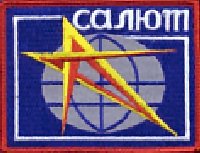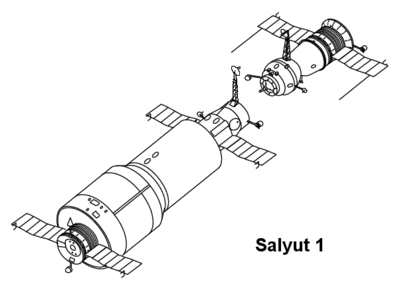Salyut 1
|
|
| Mission Insignia | |
|---|---|

| |
| Mission Statistics | |
| Mission Name: | Salyut 1 |
| Call Sign: | Salyut |
| Launch: | April 19, 1971 01:40:00 UTC Baikonur, U.S.S.R |
| Reentry: | October 11, 1971 |
| Crews: | 1 |
| Occupied: | 24 days |
| In Orbit: | 175 days |
| Number of Orbits: | 2,929 |
| Apogee: | 138 mi (222 km) |
| Perigee: | 124 mi (200 km) |
| Period: | 88.5 min |
| Inclination | 51.6 deg |
| Distance Traveled: | ~73,696,192 mi (~118,602,524 km) |
| Orbital Mass: | 18,425 kg |
| Salyut 1 | |
Salyut 1 (DOS 1) was the first Salyut space station, and the first human-made space station of any kind. It was launched April 19, 1971. Its first crew launched in Soyuz 10 but was unable to board it due to a failure in the docking mechanism; its second crew launched in Soyuz 11 and remained on board for 23 productive days. Unfortunately, a pressure-equalization valve in the Soyuz 11 reentry capsule opened prematurely when the crew returned to Earth, killing all three. Salyut 1 reentered Earth's atmosphere October 11, 1971.
Specifications
- Length - 15.8 m
- Maximum diameter - 4.15 m
- Habitable volume - 90 m³
- Weight at launch - 18,900 kg
- Launch vehicle - Proton (three-stage)
- Span across solar arrays - about 10 m
- Area of solar arrays - 28 m²
- Number of solar arrays - 4
- Resupply carriers - Salyut 1-type Soyuz
- Number of docking ports - 1
- Total manned missions - 2
- Total long-duration manned missions - 1
Visiting spacecraft and crews
Structure
At launch, the announced purpose of Salyut was to test the elements of the systems of a space station and to conduct scientific research and experiments. The craft was described as being 20 m in length, 4 m in maximum diameter, and 99 m³ in interior space with an on-orbit dry mass of 18,425 kg. Of its several compartments, three were pressurized (100 m³ total), and two could be entered by the crew. The first, or transfer, compartment was connected directly with Soyuz 11. Its docking cone had a 2 m front end diameter and a 3 m aft end diameter. The second, and main, compartment was about 4 m in diameter. Televised views showed enough space for eight big chairs (seven at work consoles), several control panels, and 20 portholes (some unobstructed by instruments). The third pressurized compartment contained the control and communications equipment, the power supply, the life support system, and other auxiliary equipment. The fourth, and final, compartment (unpressurized) was about 2 m in diameter and contained the engine installations and associated control equipment. Salyut had buffer chemical batteries, reserve supplies of oxygen and water, and regeneration systems. Externally mounted were two double sets of solar cell panels that extended like wings from the smaller compartments at each end, the heat regulation system's radiators, and orientation and control devices.
Salyut 1 Expeditions
| Expedition | Crew | Launch Date | Flight Up | Landing Date | Flight Down | Duration - Days - |
|---|---|---|---|---|---|---|
| Soyuz 11 | Georgi Dobrovolski, Viktor Patsayev, Vladislav Volkov | June 6, 1971 04:55:09 UTC | Soyuz 11 | June 29, 1971 23:16:52 UTC | Soyuz 11 | 23.77 |
Crews and missions
After taking 24 h for rendezvous and approach, Soyuz 10 docked with Salyut on April 23 and remained docked for 5.5 h. The crew did not transfer to the space station. Soyuz 11 required 3 h 19 min on June 7 to complete docking. The crew transferred to Salyut and their mission was announced as
- checking and testing the design, units, onboard systems, and equipment of the orbital piloted station
- trying out the methods and autonomous means of the station's orientation and navigation, as well as the systems for controlling the space complex while maneuvering in orbit
- studying geological-geographical objects on Earth's surface, atmospheric formations, and the snow and ice cover of Earth
- studying physical characteristics, processes, and phenomena in the atmosphere and outer space in various ranges of the spectrum of electromagnetic radiation, and
- conducting medico-biological studies to determine the possibilities of performing various jobs by the cosmonauts in the station and study the influence of space flight factors on the human organism.
On June 29, after flying 362 orbits docked with Salyut, the Soyuz 11 crew transferred back to Soyuz 11. Salyut was moved to higher orbits in July and August of 1971 to ensure that it would not end through early orbital decay. On October 11, the Salyut engines were fired, for the last time, to lower its orbit and ensure prompt decay over the Pacific Ocean. After 175 days in space, the first real space station died. Pravda (October 26, 1971) reported that the Salyut tasks were carried out in 75 percent of the cases by optical means, in 20 percent by radio-technical means, and the small balance by magneto-metrical, gravitational, and other studies. Synoptic readings were taken in both the visible and invisible parts of the electromagnetic spectrum.
See also
- Space station for statistics of occupied space stations
- Salyut
- Mir
- Skylab
- International Space Station
References
- http://nssdc.gsfc.nasa.gov/database/MasterCatalog?sc=1971-032A
- Soviet Space Stations as Analogs - NASA report (PDF format) (http://ntrs.nasa.gov/archive/nasa/casi.ntrs.nasa.gov/19870012563_1987012563.pdf)
| Previous Mission: First in series |
Salyut program | Next Mission: Salyut 2 |

